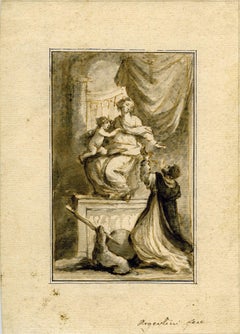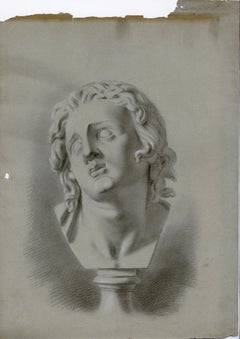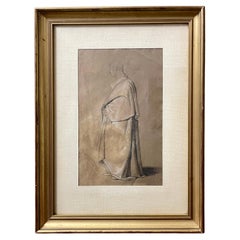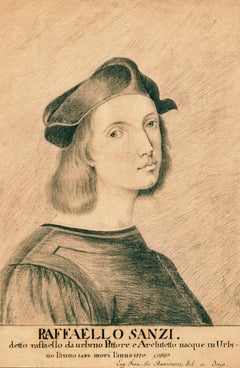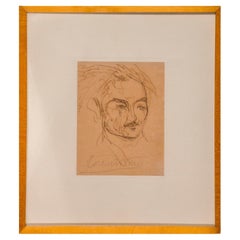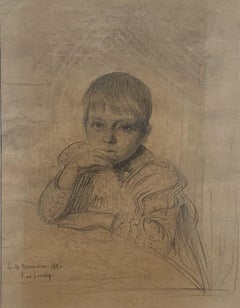Italian School Portrait Drawings and Watercolors
to
5
Overall Width
to
Overall Height
to
2
2
1
2
1,183
680
177
69
68
66
52
50
46
38
18
14
10
8
5
5
4
4
2
2
1
5
4
2
2
2
1
1
2
3
2
Style: Italian School
Neoclassical composition of a sculptor kneeling before his statue of the Madonna
Located in Middletown, NY
An allegory of loyalty, with the subject's dog pictured seated, holding his master's chisel in his mouth; fidelity personified.
Italian School, 18th century
Ink wash in gray and bl...
Category
Mid-18th Century Italian School Portrait Drawings and Watercolors
Materials
Laid Paper, Ink, Watercolor
Study of the Pergamene Head, or The Dying Alexander
Located in Middletown, NY
Graphite with white heightening on greenish beige wove paper, 17 1/4 x 12 1/2 (437 x 317 mm). Scattered edge wear, tears and losses around the perimeter of the drawing. Margins are wide and the image area is clean and intact. Scattered light soiling and toning, all consistent with age.
A dramatic image by a highly skilled draftsman, this works is likely a life study of the Hellenistic sculptural masterpiece of the same title, which is housed in the Uffizi's collection of ancient statues...
Category
Early 19th Century Italian School Portrait Drawings and Watercolors
Materials
Color Pencil, Handmade Paper, Graphite
Neoclassical Italian Drawing Framed Portrait
Located in Roma, IT
Rare and intense pencil on paper drawing attributed to the great 19th century Italian artist Domenico Morelli.
It depicts with strong character a man portrayed in three-quarter view....
Category
Mid-19th Century Italian School Portrait Drawings and Watercolors
Materials
Paper, Carbon Pencil
Portrait of Raffaello / Italian School
Located in Middletown, NY
Graphite and ink on handmade, watermarked C & I Honig laid paper, 8 15/16 x 6 3/4 inches (226 x 170 mm). Signed illegibly in ink, lower margin. Scattered light creasing and surface...
Category
18th Century Italian School Portrait Drawings and Watercolors
Materials
Handmade Paper, Ink, Graphite
1920s Italian Signed Drawing Portrait
Located in Roma, IT
Rare and important pencil drawing by one of the most important Italian Avangarde Lorenzo Viani.
It represent one of his typical subject: the portrait of the people of Viareggio, his ...
Category
Early 20th Century Italian School Portrait Drawings and Watercolors
Materials
Paper, Pencil
Related Items
French School 19th Century, A Muskeeter, original pencil drawing
Located in Paris, FR
French school 19th Century
A Muskeeter
Pencil on paper
26.5 x 17 cm
Bears a signature "F. Roybet" in the lower right
In quite good condition, bears some visible foxings,
In an old mount (some damages)
(not framed)
Even if the style, execution and of course subject are those of Ferdinand Roybet...
Category
1890s Italian School Portrait Drawings and Watercolors
Materials
Carbon Pencil
$231 Sale Price
20% Off
H 10.44 in W 6.7 in
Fernand de Launay (1855-1904) Portrait of a child, 1890, original drawing
By Fernand de Launay
Located in Paris, FR
Fernand de Launay (1838-1904)
Portrait of a child, probably the daughter of the artist
Lead pencil on paper
Signed and dated "4 septembre 1890" on the lower left
27 x 21 cm
In quite ...
Category
1890s Italian School Portrait Drawings and Watercolors
Materials
Carbon Pencil
$438 Sale Price
25% Off
H 10.63 in W 8.27 in
Ecole de Paris Mid 20th Century: Wartime Figures
By Henri Miloch
Located in Cirencester, Gloucestershire
Paris: A Wartime Study of Figures Relaxing in Springtime
by Henri Miloch (1898-1979)
Unsigned
watercolour, graphite and gouache painting on artist's paper, unframed
Sheet: 12.25 x 9...
Category
1940s Italian School Portrait Drawings and Watercolors
Materials
Watercolor, Gouache, Graphite
$535
H 12.25 in W 9.5 in D 0.1 in
Cubist Woman Study Black Pencil Drawing by Wouyart
Located in Atlanta, GA
This interesting seated woman pencil study is by French artist Wouyart (20th Century). This unique representation captures the model's expression through trace lines and shadows that...
Category
1930s Italian School Portrait Drawings and Watercolors
Materials
Paper, Pencil, Carbon Pencil
$1,900
H 21.63 in W 25.57 in D 1.19 in
1930's Original Parisian Fashion Watercolor Burgandy Dress With Green Cape
Located in Cirencester, Gloucestershire
Very stylish, unique and original 1930's French fashion design, no doubt of Parisian origin.
The painting, executed in gouache/ watercolor and pencil, is dated to the upper corner ...
Category
Mid-20th Century Italian School Portrait Drawings and Watercolors
Materials
Watercolor, Gouache, Pencil
French Art, Rococo, Portrait Queen Marie Antoinette France, Oval, Circle Vivien
Located in Greven, DE
French School, Portrait of Queen Marie Antoinette of France, Pastel /oil Pastel on Paper, Rococo, 18th Century. The Pastel is made in the style...
Category
18th Century Italian School Portrait Drawings and Watercolors
Materials
Paper, Pastel, Oil
$5,905 Sale Price
75% Off
H 16.15 in W 12.6 in
1940s Charcoal and Pencil Portrait of a Man
Located in Arp, TX
Artist Unknown
"Tie and Glasses"
c. 1940s
Charcoal and pencil on paper
13.5"x17" site 19"x23" rustic wood frame
Unsigned
Category
1940s Italian School Portrait Drawings and Watercolors
Materials
Paper, Charcoal, Carbon Pencil
Malua Rosea Multiplex (drawing paper monochrome Botany girl braids monochrome)
By Rudolf Kosow
Located in Quebec, Quebec
keywords; surrealism, portrait, oil painting, earth tones, figurative painting, strangeness, contemporary surrealistic, unsettling, contemporary figurative painting, dreams, symbolic...
Category
2010s Italian School Portrait Drawings and Watercolors
Materials
Color Pencil, Paper
$536 Sale Price
20% Off
H 16.54 in W 11.62 in D 0.08 in
Signed Feminist LGBTQ+ Colorful Ink on Paper Drawing - Courante 418.030
Located in New York, NY
Linda Stein, Courante 418.030 - Signed Feminist LGBTQ+ Colorful Ink, Color Pencil, and Graphite on Paper Drawing
Courante 418.030 is from Linda Stein's Profiles Notation series--d...
Category
2010s Italian School Portrait Drawings and Watercolors
Materials
Paper, Ink, Color Pencil, Graphite
$3,000
H 11 in W 8.5 in
1930's Original Parisian Fashion Watercolor Blue Floral Summer Dress
Located in Cirencester, Gloucestershire
Very stylish, unique and original 1930's French fashion design, no doubt of Parisian origin.
The painting, executed in gouache/ watercolor and pencil, is dated to the upper corner ...
Category
Mid-20th Century Italian School Portrait Drawings and Watercolors
Materials
Watercolor, Gouache, Pencil
Vintage art portrait - Paris, belle epoque, two elegant ladies - pastel signed
By Paul Hoeniger
Located in PARIS, FR
Currently Under restoration by professionnal.
Free US CONTINENTAL shipping, incl Europe and Asia.
Presale order accepted. Yes.
Paul Hoeniger studied at the art academies in Ber...
Category
Late 19th Century Italian School Portrait Drawings and Watercolors
Materials
Pastel, Pencil
$1,842
H 19.29 in W 11.41 in
19th Century Academic Crayon on Paper Study by Follower of Jacques-Louis David
By Jacques-Louis David
Located in Cotignac, FR
A fine French academic study sketch on paper of a classical head. The work is unsigned but very much in the style of the period and its early exponents such as Jacques-Louis David.
...
Category
19th Century Italian School Portrait Drawings and Watercolors
Materials
Paper, Crayon, Pencil, Chalk, Pastel
$755
H 13.19 in W 10.63 in D 0.6 in
Italian School portrait drawings and watercolors for sale on 1stDibs.
Find a wide variety of authentic Italian School portrait drawings and watercolors available for sale on 1stDibs. Works in this style were very popular during the 19th Century, but contemporary artists have continued to produce works inspired by this movement. Frequently made by artists working with Handmade Paper, and Paper and other materials, all of these pieces for sale are unique and have attracted attention over the years. Not every interior allows for large Italian School portrait drawings and watercolors, so small editions measuring 6.75 inches across are also available. Prices for portrait drawings and watercolors made by famous or emerging artists can differ depending on medium, time period and other attributes. On 1stDibs, the price for these items starts at $600 and tops out at $3,504, while the average work sells for $800.
